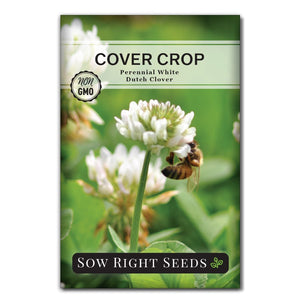The Beautiful Benefits of Using Crimson Clover as a Cover Crop
Cover crop growing tipsCrimson clover is known for its vibrant blooms and is gaining popularity as a versatile cover crop. This highly adaptable plant can thrive in various soil types and climates, making it a suitable choice for many gardeners. By planting crimson clover as a cover crop, you can prevent soil erosion, enhance nitrogen levels in the soil, support pollinators, and ultimately improve the overall quality of your soil for future crops. It's a natural and effective way to enhance your garden soil.

What is a Cover Crop?
Cover crops are grown for cover and soil health rather than for an edible harvest. Plants grown as a cover crop can help build better soil between plantings of other crops. You can learn more about the overall benefits of cover crops in this link.
Why plant crimson clover as a cover crop?
Crimson clover is one of the most adaptable cover crop plants. It can grow in a variety of soils and climates. Planting a cover crop can improve your soil in several ways. Crimson clover, in particular, can prevent erosion, fix nitrogen in the soil, and improve the soil for future crops.
Crimson clover is one of the most adaptable cover crop plants. It can grow in a variety of soils and climates. Planting a cover crop can improve your soil in several ways. Crimson clover, in particular, can prevent erosion, fix nitrogen in the soil, and improve the soil for future crops.
Crimson clover fixes nitrogen in the soil.
The roots of crimson clover are able to take nitrogen from the air and form nodules that “fix” the nitrogen into the soil where other plants can use it. Your nitrogen-loving plants will love being planted in soil where crimson clover was grown. Grow crimson clover for future crops of corn, melons, and leafy greens.
Crimson clover prevents erosion.
The fibrous taproot system of crimson clover will help prevent soil erosion in the snow and rain. This means you will have healthy garden soil for spring planting.
Crimson clover improves the soil.
Crimson clover is an important cover crop because it is a nutrient scavenger. This means it can bring up nutrients from deep in the soil, making them accessible to other plants.
Crimson clover creates a healthy pollinator habitat.
Clover is also very beneficial to your local pollinators. When the crimson flowers blossom in the spring, those hungry honey bees will be happy to feed on the pollen.
When should I plant crimson clover?
The typical time to plant crimson clover for a cover crop is right after harvesting other crops. This is usually late summer to early fall. Plant crimson clover seeds at least 6 to 8 weeks before the first frost date. This will give the plants time to become established before the cold weather makes them go dormant.
In cooler climates, crimson clover can be planted after spring crops.
Where should I plant crimson clover?
Crimson clover can be planted in raised beds and in-ground gardens. It is a popular cover crop in fruit and nut orchards as well as blueberry fields. When crimson clover is grown between trees and bushes, it is often referred to as a “green” or “living” mulch. It suppresses weeds and prevents erosion.
Crimson clover can be planted in all types of soil as long as it can drain. It won’t grow well in soils that stay waterlogged.

How to Grow Crimson Clover as a Cover Crop.
Spread crimson clover seeds over the garden soil like sowing grass seed. One packet of Sow Right Seeds Crimson Clover will be enough for one 4-foot by 8-foot garden bed.
Cover the seeds to a depth of ¼ to ⅕ inch deep. Crimson clover seeds need to be covered with enough soil to stay moist and have good soil contact. If they are too deeply planted, they will not be able to sprout.
Water the seeds and keep the soil moist. Crimson clover seeds should germinate in 7 to 21 days.
Crimson clover can also be mixed with winter oats and hairy vetch.
Using crimson clover as a green manure.
When cover crops are tilled into the soil, they are called “green manure.” For most cover crops, once they set flowers, they are ready to be mowed and turned back into the soil.
For maximum nitrogen gains, mow down or till crimson clover after it blooms but before it goes to seed.
Tilling clover into the soil will add nutrients back into the soil, making them available for subsequent crops. You can cut it down and turn it all into the ground or put the cuttings into your compost pile. Sometimes it’s too much plant material to turn into the soil. Adding the clover to your compost pile will give it time to break down and add nutrients to your compost that you can add throughout the growing season.
After tilling in crimson clover, allow 2 to 3 weeks for it to break down before planting your next crop. The process of decomposing can keep other small seeds from germinating.
Using cover crops in home gardens is an easy and effective way to improve soil naturally. The adaptability of crimson clover makes it a popular choice as a cover crop. Crimson clover can be used to increase nitrogen and other nutrients as well as prevent erosion. Its colorful blooms will attract beneficial pollinators to your garden or orchard. Planting after your vegetable harvest will improve your soil for the next round of planting in the spring.
Don’t miss out on the opportunity to improve your garden soil. We offer packets of crimson clover seed with the right amount to cover a 4’ x 8’ garden bed. Order your crimson clover seeds today. It’s time to try planting crimson clover and see what a difference it makes in your garden!
In-depth sources:
https://www.sare.org/publications/managing-cover-crops-profitably/legume-cover-crops/crimson-clover/
If you found this information helpful, share it with a gardening friend!










Is Crimson Clover allelopathic? According to Michigan State University Extension, crimson clover does have allelopathic effects. You can read more about allelopathy in their informative article. https://www.canr.msu.edu/news/cover_crops_part_2_valuable_cultural_component_of_your_organic_weed_managem
Is crimson clover allopathic ?
As a cover crop, crimson clover can take over other vegetation. It is typically not geared toward lawn usage but as a cover crop, pasture improvement, or natural tillage. We do not at this time sell bulk quantities, but our packet is designed to cover an 8 ft by 4 ft sized bed.
I am thinking of adding crimson clover to a lawn of a residential property I recently purchased. I don’t know if herbicides were used previously. Can the clover seed be broadcast sown or does it have to be covered? Is it likely to choke out the grass lawn and leave it bare after winter freeze? Do you ship bulk quantities?
Are crimson clover seeds available for purchase at this time of year?
Leave a comment